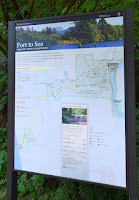Welcome to Monterey Bay!
We tried retirement, it just didn't stick. In reality, I just took the summer and fall off. That was long enough to get me back to work. Since January, Sheila and I have been living on Monterey Bay in the central California coast. I'm back to teaching alt ed high school, currently at a county juvenile hall. When you mention this area, most people probably think of beautiful views of a rocky coastline, Big Sur, or Cannery Row. But there is no doubt that there is a lot of history here in the Monterey - Salinas area too, especially compared to the rest of California. I wanted to share with you a hidden gem where you can get both scenic beauty and a little dose of history: Whalers Cove at
Point Lobos State Natural Reserve.
Point Lobos SNR is just a short ten mile drive south on Pacific Coast Highway (Hwy 1) from the
Monterey Bay Aquarium. Traveling south on Hwy 1, about a mile or two outside of Carmel you will make a right turn into the reserve. It costs ten dollars per car to get in, but totally worth it. Come early (the reserve opens to vehicles at 8 am), because this can be a popular place. I know I said it is a hidden gem, but that doesn't mean that the locals don't know about it. The ranger at the main gate can give you a map and directions, but it is a short drive to the parking lot at Whalers Cove. From there, you take a short walk back up the road to the
Whalers Cabin museum that you drove by on your way in.

Take a break from the scenery and check out
the long history of Point Lobos. The area has been occupied by non-native Americans since the 1850s. Until 1879, this spot was one of seven whaling stations along the California coast. Portuguese immigrants started shore-based whaling at this location. Crews would row out of the calmness of the small cove and past the breaking waves to hunt the grey whales that migrate up and down the California coast. You can still spot these giants as they pass by on their way south from Alaska to their breeding and calving lagoons in Baja during December through January. Or you might spot them as they return to their feeding grounds in the north, passing Monterey Bay from March through May. Of course there is more to the history of this particular spot. A community of Asian fishermen hunted abalone and canned the product here. There was a granite quarry here. The cove was used as the shipping point for a nearby coal mine. And troops trained here for specific missions during World War II. See artifacts and pictures of each of these periods in the small museum located in
the Whalers Cabin.

Luckily, Point Lobos was never developed as any kind of residential property. Ownership eventually passed to the state of California, and the site was made into an ecological reserve in 1973. That also includes 775 acres of underwater reserve, the first designated in the United States. That's good for us normal folks because the real treat here is the views of plants and animals and rocky California coast. On the day that we went, we saw sea lions, an otter, and plenty of birds. The best way to see it all is to walk. Hiking trails honeycomb the shoreline around the point. There are three main parking areas, so you'd never have to walk more than a mile from your car. Or you can leave the car where it is and walk the whole point and probably not log more than five miles.
When you vacation to Monterey, take the opportunity to visit
Point Lobos. It is very accessible and worth the time to stop. If I haven't sold you on visiting, then take a look at the
Whalers Cove Live Stream, or take a virtual hike with
Google street view. When you do come, bring a light jacket or sweatshirt as the coast here gets a marine layer at times that can be a bit chilly, especially if you just left the warmer interior.













